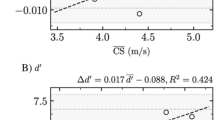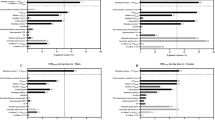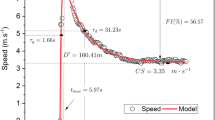Abstract
The purpose of this study was to evaluate the validity of maximal velocity (V max) estimated from three-parameter systems models, and to compare the predictive value of two- and three-parameter models for the 800 m. Seventeen trained male subjects \( ({\text{\ifmmode\expandafter\dot\else\expandafter\.\fi{V}O}}_{2} \max = 66.54 \pm 7.29\,{\text{ml}}\,{\text{min}} ^{{ - 1}} \,{\text{kg}}^{{ - 1}} ) \) performed five randomly ordered constant velocity tests (CVT), a maximal velocity test (mean velocity over the last 10 m portion of a 40 m sprint) and a 800 m time trial (V 800 m). Five systems models (two three-parameter and three two-parameter) were used to compute V max (three-parameter models), critical velocity (CV), anaerobic running capacity (ARC) and V 800 m from times to exhaustion during CVT. V max estimates were significantly lower than (0.19<Bias<0.24 m s−1) and poorly associated (0.44<r<0.49) with actual V max (8.43±0.33 m s−1). Critical velocity (CV) alone explained 40–62% of the variance in V 800 m. Combining CV with other parameters of each model to produce a calculated V 800 m resulted in a clear improvement of this relationship (0.83<r<0.94). Three-parameter models had a better association (0.93<r<0.94) and a lower bias (0.00<Bias<0.04 m s−1) with actual V 800 m (5.87±0.49 m s−1) than two-parameter models (0.83<r<0.91, 0.06<Bias<0.20). If three-parameter models appear to have a better predictive value for short duration events such as the 800 m, the fact the V max is not associated with the ability it is supposed to reflect suggests that they are more empirical than systems models.


Similar content being viewed by others
References
Arsac LM, Locatelli E (2002) Modeling the energetics of 100-m running by using speed curves of world champions. J Appl Physiol 92:1781–1788
Billat LV, Koralsztein JP, Morton RH (1999) Time in human endurance models. From empirical models to physiological models. Sports Med 27:359–379
Bishop D, Jenkins DG, Howard A (1998) The critical power function is dependent on the duration of the predictive exercise tests chosen. Int J Sports Med 19:125–129
Bland JM, Altman DG (1986) Statistical methods for assessing agreement between two methods of clinical measurement. Lancet 1:307–310
Bosquet L, Leger L, Legros P (2002) Methods to determine aerobic endurance. Sports Med 32:675–700
Bull AJ, Housh TJ, Johnson GO, Perry SR (2000) Effect of mathematical modeling on the estimation of critical power. Med Sci Sports Exerc 32:526–530
Cohen J (1988) Statistical power analysis for the behavioral sciences. Lawrence Erlbaum Associates, Hillsdale, pp 1–567
di Prampero PE (1999) The concept of critical velocity: a brief analysis. Eur J Appl Physiol Occup Physiol 80:162–164
Ettema JH (1966) Limits of human performance and energy production. Int Z für Angew Physiol Einschl Arbeitphysiol 22:45–54
Florence S, Weir JP (1997) Relationship of critical velocity to marathon running performance. Eur J Appl Physiol Occup Physiol 75:274–278
Frishberg BA (1983) An analysis of overground and treadmill sprinting. Med Sci Sports Exerc 15:478–485
Gaesser GA, Carnevale TJ, Garfinkel A, Walter DO, Womack CJ (1995) Estimation of critical power with nonlinear and linear models. Med Sci Sports Exerc 27:1430–1438
Gastin PB (2001) Energy system interaction and relative contribution during maximal exercise. Sports Med 31:725–741
Green S, Dawson BT, Goodman C, Carey MF (1994) Y-intercept of the maximal work–duration relationship and anaerobic capacity in cyclists. Eur J Appl Physiol Occup Physiol 69:550–556
Hill AV (1927) Muscular movement in man: the factors governing speed and recovery from fatigue. McGraw-Hill, New York, pp 41–44
Hill DW (1993) The critical power concept. A review. Sports Med 16:237–254
Hill DW, Smith JC (1993) A comparison of methods of estimating anaerobic work capacity. Ergonomics 36:1495–1500
Hill DW, Alain C, Kennedy MD (2003) Modeling the relationship between velocity and time to fatigue in rowing. Med Sci Sports Exerc 35:2098–2105
Hopkins WG, Edmond IM, Hamilton BH, Macfarlane DJ, Ross BH (1989) Relation between power and endurance for treadmill running of short duration. Ergonomics 32:1565–1571
Housh DJ, Housh TJ, Bauge SM (1990) A methodological consideration for the determination of critical power and anaerobic work capacity. Res Q Exerc Sport 61:406–409
Housh TJ, Cramer JT, Bull AJ, Johnson GO, Housh DJ (2001) The effect of mathematical modeling on critical velocity. Eur J Appl Physiol 84:469–475
Hughson RL, Orok CJ, Staudt LE (1984) A high velocity treadmill running test to assess endurance running potential. Int J Sports Med 5:23–25
Jenkins DG, Quigley BM (1991) The y-intercept of the critical power function as a measure of anaerobic work capacity. Ergonomics 34:13–22
Kolbe T, Dennis SC, Selley E, Noakes TD, Lambert MI (1995) The relationship between critical power and running performance. J Sports Sci 13:265–269
Kranenburg KJ, Smith DJ (1996) Comparison of critical speed determined from track running and treadmill tests in elite runners. Med Sci Sports Exerc 28:614–618
Lacour JR, Bouvat E, Barthelemy JC (1990) Post-competition blood lactate concentrations as indicators of anaerobic energy expenditure during 400-m and 800-m races. Eur J Appl Physiol Occup Physiol 61:172–176
Margaria R, Aghemo P, Pinera Limas F (1975) A simple relation between performance in running and maximal aerobic power. J Appl Physiol 38:351–352
Medbo JI, Burgers S (1990) Effect of training on the anaerobic capacity. Med Sci Sports Exerc 22:501–507
Monod H, Scherrer J (1965) The work capacity of a synergic muscular group. Ergonomics 329–338
Moritani T, Nagata A, deVries HA, Muro M (1981) Critical power as a measure of physical work capacity and anaerobic threshold. Ergonomics 24:339–350
Morton RH (1996) A 3-parameter critical power model. Ergonomics 39:611–619
Morton RH, Hodgson DJ (1996) The relationship between power output and endurance: a brief review. Eur J Appl Physiol Occup Physiol 73:491–502
Nebelsick-Gullett LJ, Housh TJ, Johnson GO, Bauge SM (1988) A comparison between methods of measuring anaerobic work capacity. Ergonomics 31:1413–1419
Pepper ML, Housh TJ, Johnson GO (1992) The accuracy of the critical velocity test for predicting time to exhaustion during treadmill running. Int J Sports Med 13:121–124
Ross A, Leveritt M (2001) Long-term metabolic and skeletal muscle adaptations to short-sprint training: implications for sprint training and tapering. Sports Med 31:1063–1082
Scott CB, Roby FB, Lohman TG, Bunt JC (1991) The maximally accumulated oxygen deficit as an indicator of anaerobic capacity. Med Sci Sports Exerc 23:618–624
Smith CG, Jones AM (2001) The relationship between critical velocity, maximal lactate steady-state velocity and lactate turnpoint velocity in runners. Eur J Appl Physiol 85:19–26
Vandewalle H, Peres G, Monod H (1987) Standard anaerobic exercise tests. Sports Med 4:268–289
Vandewalle H, Kapitaniak B, Grun S, Raveneau S, Monod H (1989) Comparison between a 30-s all-out test and a time-work test on a cycle ergometer. Eur J Appl Physiol Occup Physiol 58:375–381
Vandewalle H, Vautier JF, Kachouri M, Lechevalier JM, Monod H (1997) Work–exhaustion time relationships and the critical power concept. A critical review. J Sports Med Phys Fitness 37:89–102
Whipp BJ, Huntsman DJ, Storer T, Lamarra N, Wasserman K (1982) A constant which determines the duration of tolerance to high intensity work. Fed Proc 41:1591
Acknowledgements
The authors are indebted to the Direction Régionale et Départementale de la Jeunesse et des Sports Nord-Pas-de-Calais for the financial support.
Author information
Authors and Affiliations
Corresponding author
Rights and permissions
About this article
Cite this article
Bosquet, L., Duchene, A., Lecot, F. et al. V max estimate from three-parameter critical velocity models: validity and impact on 800 m running performance prediction. Eur J Appl Physiol 97, 34–42 (2006). https://doi.org/10.1007/s00421-006-0143-7
Accepted:
Published:
Issue Date:
DOI: https://doi.org/10.1007/s00421-006-0143-7




